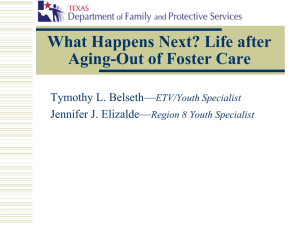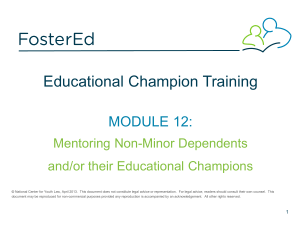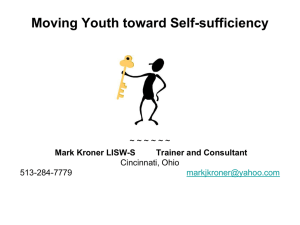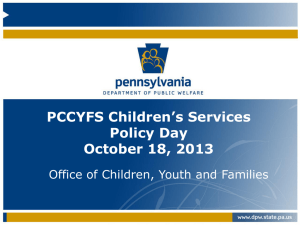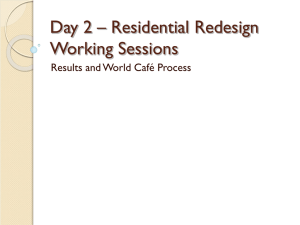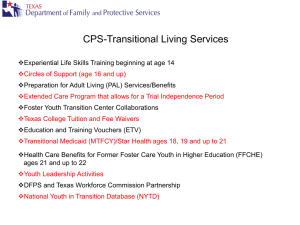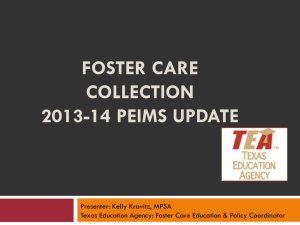Child Welfare, Education, and the Courts
advertisement
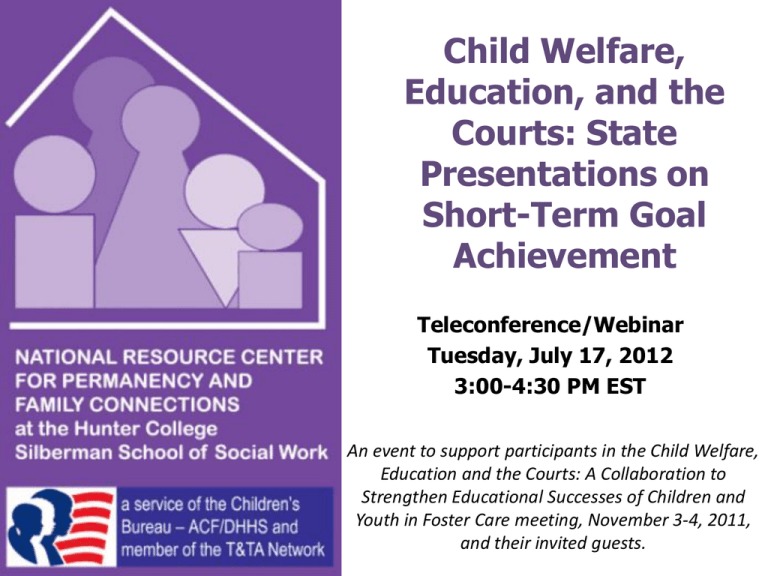
Child Welfare, Education, and the Courts: State Presentations on Short-Term Goal Achievement Teleconference/Webinar Tuesday, July 17, 2012 3:00-4:30 PM EST An event to support participants in the Child Welfare, Education and the Courts: A Collaboration to Strengthen Educational Successes of Children and Youth in Foster Care meeting, November 3-4, 2011, and their invited guests. Agenda • Introduction and Welcome • New York Presentation: Early Stage Collaboration • Texas Presentation: Interagency Collaboration • Michigan Presentation: Post-Secondary Support for Youth in Care • Discussion/Questions and Answers EDUCATIONAL STABILITY: EARLY STAGE COLLABORATION IN NEW YORK COLLABORATION PRIOR TO FALL 2011 • A strong collaborative relationship existed between the NYS Office of Children & Family Services (OCFS) and the NYS Unified Court System (the courts). • There was little collaboration between OCFS, the courts and the State Education Department (State Ed). • Educational Stability Conference: reaction FIRST STEPS A team of representatives from the three systems attended the Child Welfare, Education and the Courts conference in Arlington, VA in November 2011 where we identified short and long-term goals. • Within two weeks of the conference a follow up conference call occurred where we identified members we wanted on the larger team and discussed engagement strategies. • On 12/5/11 we had the first meeting of the new team, reviewed the action plan and assigned tasks to various members. Strengths: existing child welfare/court collaboration • Statewide court/child welfare collaboration team • 21 local court/child welfare collaborative teams in counties with the highest foster care population • Collaboration at the system leadership level • In the process of developing regional collaborative teams • Established relationship and understanding of one another’s systems • Built trust and open communication The education system perspective • Challenges • Rewards: Supporting educational stability and support for foster children will enhance overall school performance Leveraging ongoing work • Permanency Hearing Report • Adolescent well-being training • Other court training Team Accomplishments Team formation and building Joint guidance document Grant application Future directions Data sharing Transportation costs Communication issues Child Welfare, Education and the Courts: A Collaboration to Strengthen Educational Successes of Children and Youth in Foster Care July 17, 2012 Jenny Hinson Division Administrator for Permanency Texas Department of Family and Protective Services • Supreme Court of Texas Permanent Judicial Commission for Children, Youth and Families • Texas Education Agency • Texas Department of Family and Protective Services • Houston Independent School District Established in November 2007 by Supreme Court of Texas Order • chaired by Justice Eva Guzman • 24 members, including judges, legislators, agency leaders, private foundations, family and corporate lawyers • 40+ members on multi-disciplinary Collaborative Council that serves in advisory role May 20, 2010 Supreme Court of Texas signed order Establishing Education Committee of Permanent Judicial Commission for Children, Youth and Families. Charged to look at challenges, identify judicial practices and crossdisciplinary training needs, improve collaboration, and make recommendations regarding education. Focused on improving educational outcomes of foster children and youth. Seek to improve collaboration, communication & practice through partnerships with DFPS, TEA, and stakeholders in education and child protection community. Coordinated effort of numerous agencies and systems involved with child protection and education. 100 Stakeholders. Over 100 recommendations & strategies identified related to: School readiness, School Stability & Transitions, School Experience, Supports & Advocacy, Post Secondary Education. 17 month Federal Demonstration Grant from the Administration for Children and Families, Children’s Bureau (February 2013). Build model collaboration: Texas Education Agency; Department of Family and Protective Services; the Supreme Court of Texas Permanent Judicial Commission for Children, Youth and Families; and Houston Independent School District Program Evaluation : University of Texas – Child & Family Research Institute Prioritize & Implement: Education Committee Recommendations and Strategies to implement in Houston pilot. Facilitate improved coordination & practice: both state and local level between court, child welfare, and education systems. Produce deliverables: “online resource guide” with protocols, tools, training, long-term plan for dissemination and sustained collaboration. Joint DFPS & HISD Implementation Team. DFPS: Division Director; Program Directors: Adoption Preparation, Program Director Family Based Safety Services, Investigation, Special Investigators; Disability Specialist; Education Specialist; Legal Liaison Supervisor; Foster Care Alumni – Youth Specialist; and Disproportionality Specialist. HISD: Manager Counseling Servings/ School District Foster Care Liaison; Manager Student Engagement/McKinney Vento Liaison; Program Specialist & Parent Liaison Special Education; Foster Care Education Coordinator. HHS: Disproportionality & Disparities Regional Specialist 1 High School & 1 Feeder Middle School Operationalize identified Texas Blueprint Recommendations/Strategies to inform state recommended practices. (Enrollment, Care Team & Data Sharing) DFPS, Ensuring Education Stability Data Sharing: Improved processes for collaboration & cross system analysis. Existing MOU’s (SB. 939) shared Aggregate Data Establish baselines for student outcome data Model MOU between DFPS & HISD. Facilitate uniformed system for enrolling youth. Create on-line resources; including tools, protocols and materials for cross-system training. Identify & develop communication/training for new foster care liaisons appointed in 1200+ school districts. Replicating leadership commitment: High level commitment to collaboration, does not ensure that collaboration will be smoothly carried out through subsequent levels within agencies and systems. Allow time to build infrastructure for collaboration: This is necessary & takes time, which should be accounted for in ALL new collaborative efforts. Time necessary varies based on location of project – state level collaboration requires different demands of local/regional collaborations. Cross-Agency collaboration adds time to project tasks & decision making: Working in large bureaucracies and complex systems ensures that every task takes much more time than anticipated. Working across-agencies adds significantly to time needed for accomplishing each deliverable. Develop shared goals and clear expectations that are communicated in writing and understood by all participants early in collaboration process. Allow time to develop a shared language and a strong understanding of crosssystem partners. Agency jargon, Decision making & approval processes, Agency & personal limitations, Agency authority – State control, local control, etc. Identify individual & collaboration responsibilities, etc. Developing trust among stakeholders is needed to effectively work with cross agency partners. Post-Secondary Supports for Youth in Foster Care Michigan Department of Human Services Bureau of Child Welfare, Permanency Division Health, Education and Youth Unit July 17, 2012 Michigan’s Goal • Involve and assist all Michigan colleges and universities in developing supportive programs that provide stability for foster youth engaged in post-secondary pursuits. Education Summit Planning • November 2011 – DHS Director Corrigan requested that a summit be held for colleges to hear about the needs of foster youth. • December 2011 – Planning group formed. – DHS – Central Office. – DHS local education planner. – Treasury Department. – Oakland Community College. – Education and Training Voucher program staff. Education Summit Planning • Invited college presidents and chancellors. – 15 public universities. – 28 community colleges. – Over 40 private institutions. • Added financial aid directors. Education Summit Planning • Letter sent directly to presidents and chancellors from DHS Director Corrigan encouraging them to attend the summit. • Follow-up email sent. • Hard-copy invitation flyers. Education Summit Agenda • Started the day with 2 brief presentations: • Dr. John Seita from Michigan State University discussed the needs of foster youth when entering college. • Paul Blavin explained why he started a program on the campus of University of Michigan. Education Summit Agenda Youth Panel – Most important part of the day! • Former foster youth spoke about their experiences on a college campus. • The panel included a variety of youth, from both community colleges, colleges and universities. Education Summit Agenda • Presidents from four universities with foster care specific programs presented on their programs. – Ferris State University. – Michigan State University. – University of Michigan. – Western Michigan University. • Discussed their commitment to better serving foster youth. Education Summit Follow-Up • Satisfaction survey sent through Survey Monkey. • Emails sent to participants: – Thanked them for attending. – Offered to meet to discuss questions as they move forward with program development. – Announced the posting of a Request for Proposal (RFP) for Independent Living Skills Coach Contracts. IL Skills Coach Contracts • Western Michigan University Campus Coach Model. • Coaches available 24/7/365 to assist students with all aspects of independent living. • Casey Family Programs – 7 life domains: • • • • • • • Education Employment Housing Physical and mental health Supportive relationships and community connections Cultural and personal identity formation Life skills. IL Skills Coach Contracts • DHS utilized $600,000 of Youth-In-Transition line item to fund contracts for post-secondary institutions to provide on-site IL skills training to foster and former foster youth. • March 2012 – Posted RFP. • Awarded three contracts: • Baker College of Flint. • Ferris State University. • Michigan State University. • Posted again in June 2012. IL Skills Coach Contracts • Contract requirements: • • • • • Master’s level IL coaches. Coaches are clinically and trauma trained. Collaboration across campus. Collaboration across community. Mentor program • Mentor training specific to the need of foster youth on campus. • Mentors that are educated or employed in the same area of study as the youth they are mentoring. Contacts Ann Rossi, Education Specialist Health, Education and Youth Unit RossiA@michigan.gov, 517-373-2851 Janet Kaley, Manager Health, Education and Youth Unit KaleyJ@michigan.gov, 517-241-2507 Mary Chaliman, Director Permanency Division ChalimanM2@michigan.gov, 517-335-4151 Questions ???????? Press *1 on your phone to ask a question. After the Event • A feedback survey will be emailed to all participants. We appreciate your feedback! • Materials for this event are currently posted on the NRCPFC website at: http://www.nrcpfc.org/teleconfe rences/2012-07-17.html • The event will be archived on Wednesday 7/25/12 at: http://www.nrcpfc.org/educatio n_summit/whats_new.html
